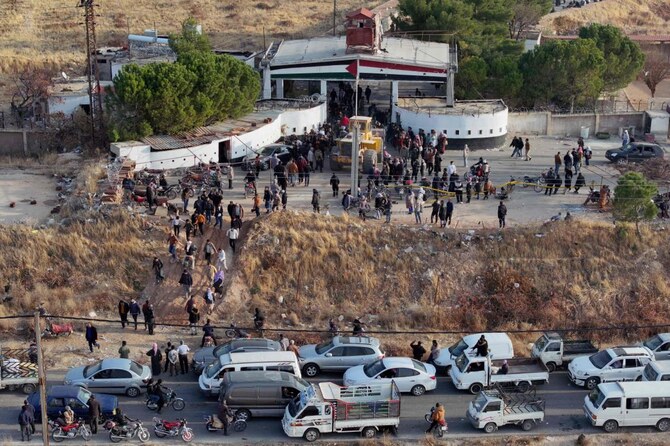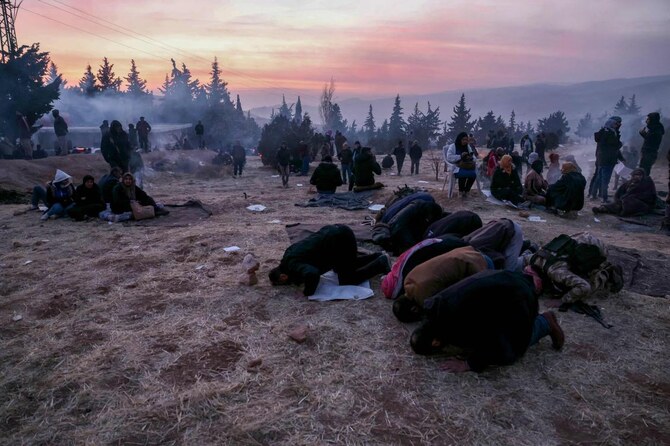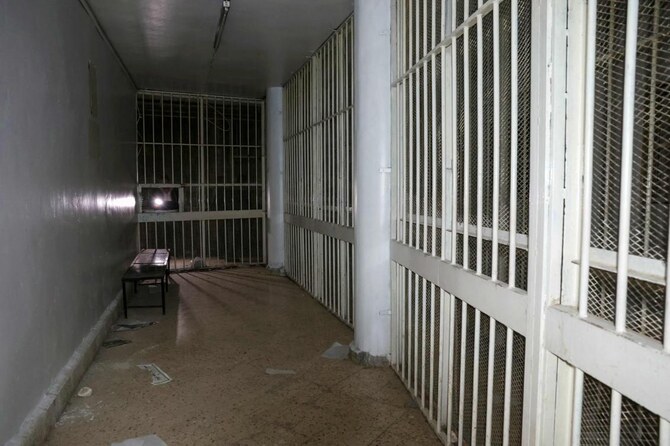DAMASCUS: They came from all over Syria, tens of thousands. The first place they rushed to after the fall of their longtime tormentor, former President Bashar Assad, was here: Saydnaya Prison, a place so notorious for its horrors it was long known as “the slaughterhouse.”
For the past two days, all have been looking for signs of loved ones who disappeared years or even decades ago into the secretive, sprawling prison just outside Damascus.
But hope gave way to despair Monday. People opened the heavy iron doors lining the hallways to find cells inside empty. With sledgehammers, shovels and drills, men pounded holes in floors and walls, looking for what they believed were secret dungeons, or chasing sounds they thought they heard from underground. They found nothing.
Insurgents freed dozens of people from the Saydnaya military prison on Sunday when Damascus fell. Since then, almost no one has been found.
“Where is everyone? Where are everyone’s children? Where are they?” said Ghada Assad, breaking down in tears.
She had rushed from her Damascus home to the prison on the capital’s outskirts, hoping to find her brother. He was detained in 2011, the year that protests first erupted against the former president’s rule – before they turned into a long, grueling civil war. She didn’t know why he was arrested.
“My heart has been burned over my brother. For 13 years, I kept looking for him,” she said. When insurgents last week seized Aleppo — her original hometown — at the start of their swiftly victorious offensive, “I prayed that they would reach Damascus just so they can open up this prison,” she said.
Civil defense officials helping in the search were as confused as the families over why no further inmates were being found. It appeared fewer were held here in recent weeks, they said.
But few were giving up, a sign of how powerfully Saydnaya looms in the minds of Syrians as the heart of Assad’s brutal police state. The sense of loss over the missing — and the sudden hope they might be found — brought a kind of dark unity among Syrians from across the country.
During Assad’s rule and particularly after the 2011 protests began, any hint of dissent could land someone in Saydnaya. Few ever emerged.
In 2017, Amnesty International estimated that 10,000-20,000 people were being held there at the time “from every sector of society.” It said they were effectively slated for “extermination.”
Thousands were killed in frequent mass executions, Amnesty reported, citing testimony from freed prisoners and prison officials. Prisoners were subjected to constant torture, intense beatings and rape. Almost daily, guards did rounds of the cells to collect bodies of inmates who had died overnight from injuries, disease or starvation. Some inmates fell into psychosis and starved themselves, the human rights group said.
“There is not a home, there is not a woman in Syria who didn’t lose a brother, a child or a husband,” said Khairiya Ismail, 54. Two of her sons were detained in the early days of the protests against Assad – one of them when he came to visit her after she herself had been detained.
Ismail, accused of helping her son evade military service, spent eight months in Adra prison, northeast of Damascus. “They detained everyone.”
An estimated 150,000 people were detained or went missing in Syria since 2011 — and tens of thousands of them are believed to have gone through Saydnaya.
“People expected many more to be here ... They are clinging to the slightest sliver of hope,” said Ghayath Abu Al-Dahab, a spokesman for the White Helmets, the search and rescue group that operated in rebel-held areas throughout the war.
Five White Helmet teams, with two canine teams, came to Saydnaya to help the search. They even brought in the prison electrician, who had the floor plan, and went through every shaft, vent and sewage opening. So far, there were no answers, Abu Al-Dahab said.
He said the civil defense had documents showing more than 3,500 people were in Saydnaya until three months before the fall of Damascus. But the number may have been less by the time the prison was stormed, he said.
“There are other prisons,” he said. “The regime had turned all of Syria into a big prison.” Detainees were held in security agencies, military facilities, government offices and even universities, he added.
Around the Y-shaped main building of the prison, everyone kept trying, convinced they could find some hidden chamber with detainees, dead or alive.
Dozens of men tried to force a metal gate open until they realized it led only to more cells upstairs. Others asked the insurgents guarding the prison to use their rifle to lever open a closed door.
A handful of men were gathered, excavating what looked like a sewage opening in a basement. Others dug up electrical wiring, thinking it might lead to hidden underground chambers.
In a scene throughout the day, hundreds cheered as men with sledgehammers and shovels battered a huge column in the building’s atrium, thinking they had found a secret cell. Hundreds ran to see. But there was nothing, and tears and loud sighs replaced the celebrations.
In the wards, lines of cells were empty. Some had blankets, a few plastic pots or a few names scribbled on walls. Documents, some with names of prisoners, were left strewn in the yard, the kitchen and elsewhere. Families scoured them for their loved ones’ names.
A brief protest broke out in the prison yard, when a group of men began chanting: “Bring us the prison warden.” Calls on social media urged anyone with information of the secret cells of the prison to come forth and help.
Firas Al-Halabi, one of the prisoners freed when insurgents first broke into Saydnaya, was back on Monday visiting. Those searching flocked around him, whispering names of relatives to see if he met them.
Al-Halabi, who had been an army conscript when he was arrested, said he spent four years in a cell with 20 others.
His only food was a quarter loaf of bread and some burghul. He suffered from tuberculosis because of the cell conditions. He was tortured by electrocution, he said, and the beatings were constant.
“During our time in the yard, there was beating. When going to the bathroom, there was beating. If we sat on the floor, we got beaten. If you look at the light, you are beaten,” he said. He was once thrown into solitary for simply praying in his cell.
“Everything is considered a violation,” he said. “Your life is one big violation to them.”
He said that in his first year in the prison guards would call out hundreds of names over the course of days. One officer told him it was for executions.
When he was freed Sunday, he thought he was dreaming. “We never thought we would see this moment. We thought we would be executed, one by one.”
Noha Qweidar and her cousin sat in the yard on Monday, taking a rest from searching. Their husbands were detained in 2013 and 2015. Qweidar said she had received word from other inmates that her husband was killed in a summary execution in prison.
But she couldn’t know for sure. Prisoners reported dead in the past have turned up alive.
“I heard that (he was executed) but I still have hope he is alive.”
Just before sundown on Monday, rescue teams brought in an excavator to dig deeper.
But late at night, the White Helmets announced the end of their search, saying in a statement they had found no hidden areas in the facility.
“We share the profound disappointment of the families of the thousands who remain missing and whose fates are unknown.”
Thousands scour Syria’s most horrific prison but find no sign of their loved ones
https://arab.news/4zadu
Thousands scour Syria’s most horrific prison but find no sign of their loved ones

Jordanian king chairs security meeting, affirms national unity amid regional tensions

- King Abdullah II said that Jordan will not permit any party to exploit regional tensions to undermine the country’s firm stance on key Arab issues
- The Iran-Israel conflict has escalated following US strikes on Sunday, as Tel Aviv and Tehran exchanged attacks for the 10th day
LONDON: King Abdullah II of Jordan chaired a meeting on Sunday with officials and security agencies to emphasize national unity in the face of regional developments.
King Abdullah urged government institutions to tackle the economic effects of escalating tensions in the Middle East during the meeting at Al-Husseiniya Palace in Amman.
He said that Jordan will not permit any party to exploit regional tensions to undermine the country’s firm stance on key Arab issues. He said that Amman is committed to achieving a ceasefire in the Gaza Strip and the establishment of a Palestinian state, the Petra news agency reported.
He called for increased international efforts to achieve lasting peace in the region and to de-escalate tensions through diplomatic dialogue and negotiations, Petra added.
The Iran-Israel conflict has escalated following US strikes on three nuclear sites inside Iran on Sunday morning. Tel Aviv and Tehran have exchanged attacks over the past 10 days, risking a full-scale war in the Middle East.
The meeting was attended by several key figures, including Prime Minister Jafar Hassan, Foreign Minister Ayman Safadi, Speaker of the House of Representatives Ahmad Safadi, Chairman of the Joint Chiefs of Staff Maj. Gen. Yousef Huneiti, General Intelligence Department Director Maj. Gen. Ahmad Husni, and Public Security Directorate Director Maj. Gen. Obaidallah Maaytah.
Blast rocks church in Syria’s Damascus, witnesses say

DAMASCUS: A blast rocked the Mar Elias Church in the Dweila neighborhood of Syria’s capital Damascus on Sunday, according to witnesses.
One told Reuters a suicide bomber detonated himself inside the church. A spokesperson for Damascus security forces did not immediately respond to a request for comment.
Israeli authorities arrest four Al-Aqsa guards, storm old prayer hall

- Israeli forces storm prayer hall beneath the Qibli Mosque, damaging its contents
- Jerusalem Governorate says action is part of efforts to assert control over the mosque’s administration and undermine the Waqf authority
LONDON: Israeli authorities arrested four guards at the Al-Aqsa Mosque during a search raid on Saturday night inside the compound’s old prayer hall.
The Jerusalem Governorate, affiliated with the Palestinian Authority, said that the detainees were identified as Mohammad Arbash, Ramzi Al-Zaanin, Basem Abu Juma, and Iyad Odeh. Several other guards and a firefighter in the compound were interrogated at the site by Israelis, the Wafa news agency reported.
Just after midnight on Saturday, Israeli forces stormed the old prayer hall at Al-Aqsa, a subterranean area beneath the Qibli Mosque, damaging its contents after breaking into storage cabinets and searching the premises, Wafa added.
The governorate said the latest Israeli action was part of efforts to assert control over the mosque’s administration and undermine the authority of the Islamic Waqf Department in Jerusalem.
After less than a week of complete closure under a state of emergency linked to the ongoing war with Iran, the Al-Aqsa Mosque was reopened by Israeli authorities, allowing Palestinian and other Muslim worshippers to enter the site under strict regulations, Wafa reported.
Palestinian Authority considers phasing out shekel as Israeli banks refuse to accept surplus

- Israeli banks’ refusal to accept the transfer of surplus shekels means fewer foreign currencies that are necessary for commerce and business
- Israel’s finance minister in June ended a waiver that allowed Israeli banks to engage with Palestinian ones without being scrutinized for money laundering and financing extremism
LONDON: The Palestinian Authority is considering replacing the Israeli shekel as the primary currency in circulation due to its increasing accumulation in the banks.
The Palestine Monetary Authority announced on Sunday that it has taken significant steps to address the growing accumulation of shekels in Palestinian banks after Israeli banks’ continuing refusal to accept the transfer of surplus shekels in exchange for foreign currencies necessary for commerce and business.
The PMA is considering alternative options, including a shift away from using the shekel as the primary currency in circulation, the Wafa news agency reported.
In early June, Israeli Finance Minister Bezalel Smotrich ended a waiver that allowed Israeli banks to engage with Palestinian banks without being scrutinized for money laundering and financing extremism.
Smotrich, who has been outspoken about weakening the Palestinian Authority and opposes the establishment of a Palestinian state, made this decision shortly after being sanctioned by the UK and four European countries for inciting violence in the occupied West Bank.
The PMA said it aims to create a more resilient and sustainable digital economy in Palestine and has consulted various economic sectors and the Union of Chambers of Commerce, Industry, and Agriculture before it makes a final decision. Alongside phasing out the Israeli shekel, the PMA studied digital payment strategies to avoid shekel accumulation in Palestinian banks, Wafa reported.
How many hostages are left in Gaza?

- 50 hostages remain in captivity
- PM Netanyahu said Israel is committed to returning the remaining hostages even as it wages a new military campaign against Iran
Israel said Sunday that it has recovered the bodies of three more hostages taken in Hamas’ Oct. 7 attack that ignited the ongoing 20-month war in the Gaza Strip.
The Israeli military identified them as Yonatan Samerano, 21; Ofra Keidar, 70; and Shay Levinson, 19. All three were killed during the initial attack and their bodies were taken into Gaza. Kobi Samerano said in a Facebook post that his son’s remains were returned on what would have been Yonatan’s 23rd birthday.
The military did not provide details about the operation. Prime Minister Benjamin Netanyahu said Israel is committed to returning the remaining hostages even as it wages a new military campaign against Iran.
Hamas-led militants killed some 1,200 people, mostly civilians, and took 251 hostages in the Oct. 7 attack. More than 55,000 Palestinians in Gaza, mostly women and children, have been killed in the ensuing conflict, according to Gaza’s Health Ministry. The ministry doesn’t distinguish between civilians and combatants.
Here are details on the hostages:
Total hostages captured on Oct. 7, 2023: 251
Hostages taken before the Oct. 7 attack: 4, including 2 who entered Gaza in 2014 and 2015 and the bodies of 2 soldiers killed in the 2014 war
Hostages released in exchanges or other deals: 148, of whom 8 were dead
Bodies of hostages retrieved by Israeli forces: 49
Hostages rescued alive: 8
Hostages still in captivity: 50, of whom Israel believes 27 are dead. Netanyahu has said there are “doubts” about the fate of several more.
The hostages in captivity include four non-Israelis: 2 Thais and 1 Tanzanian who have been confirmed dead, and a Nepalese captive.























